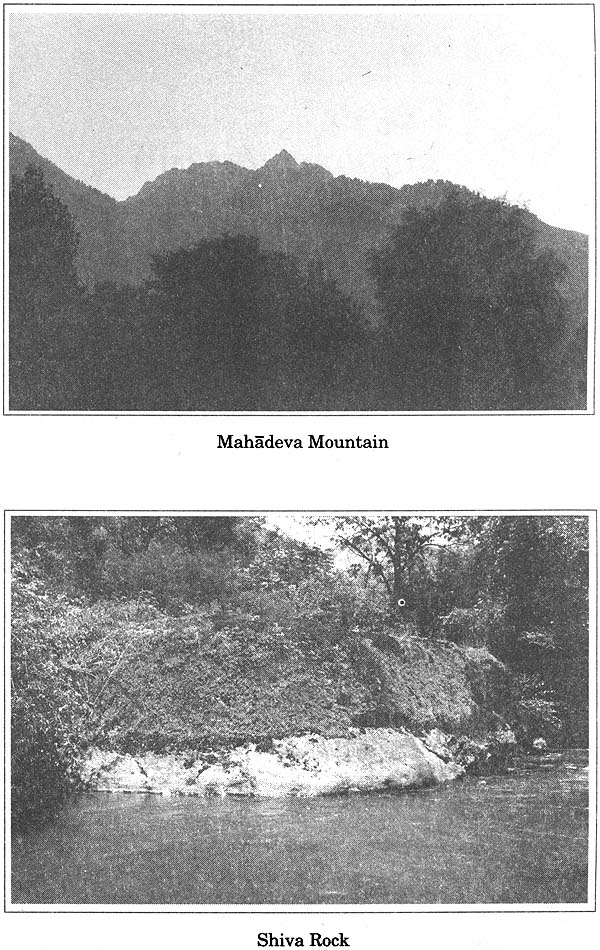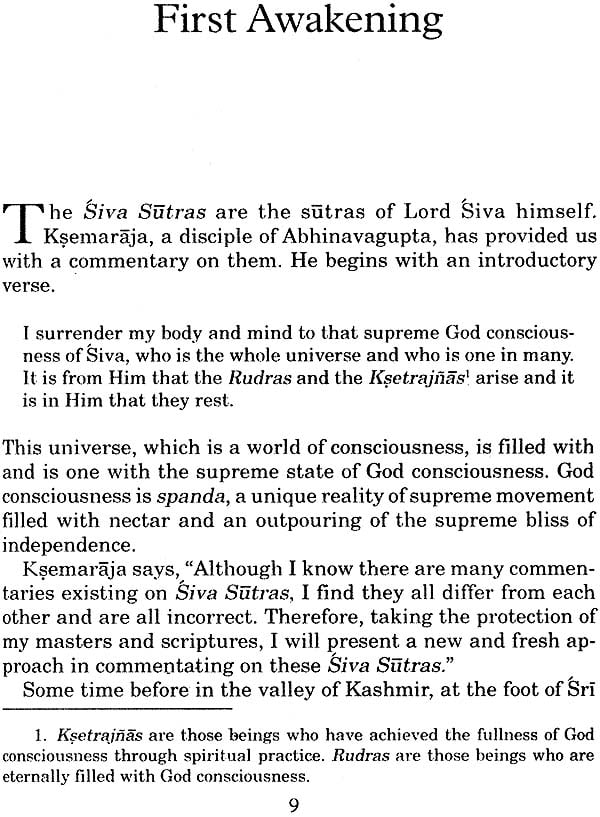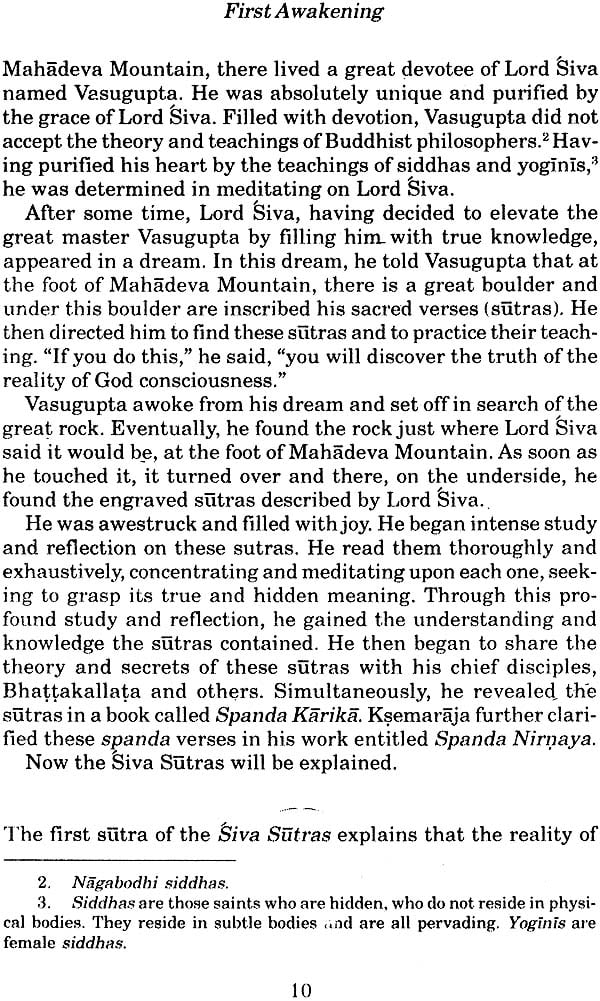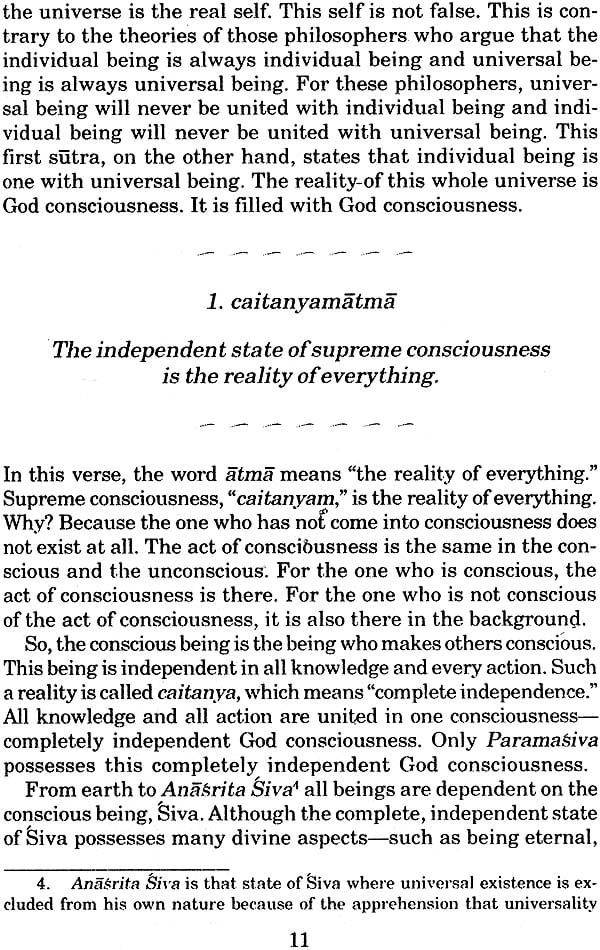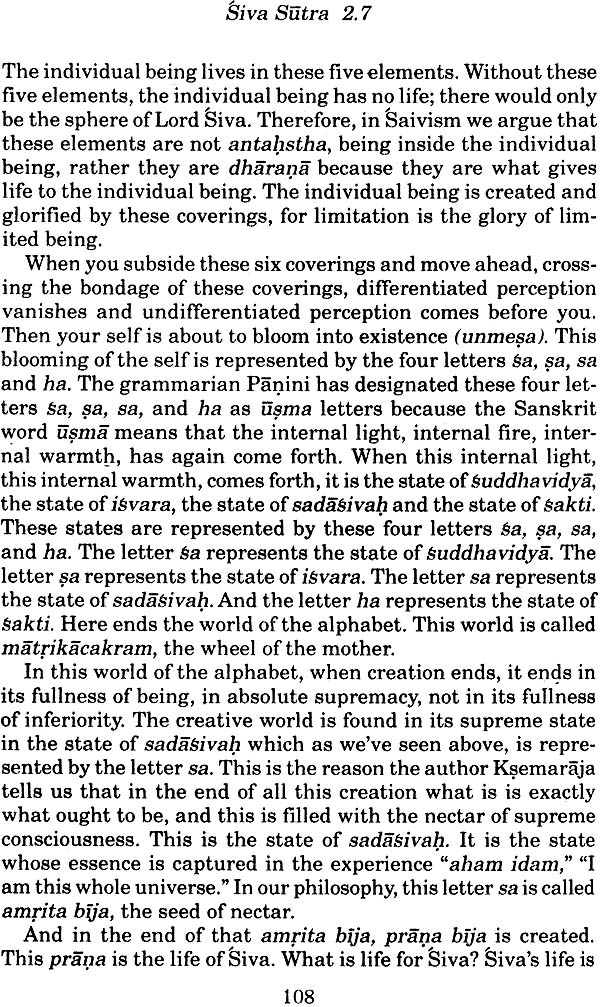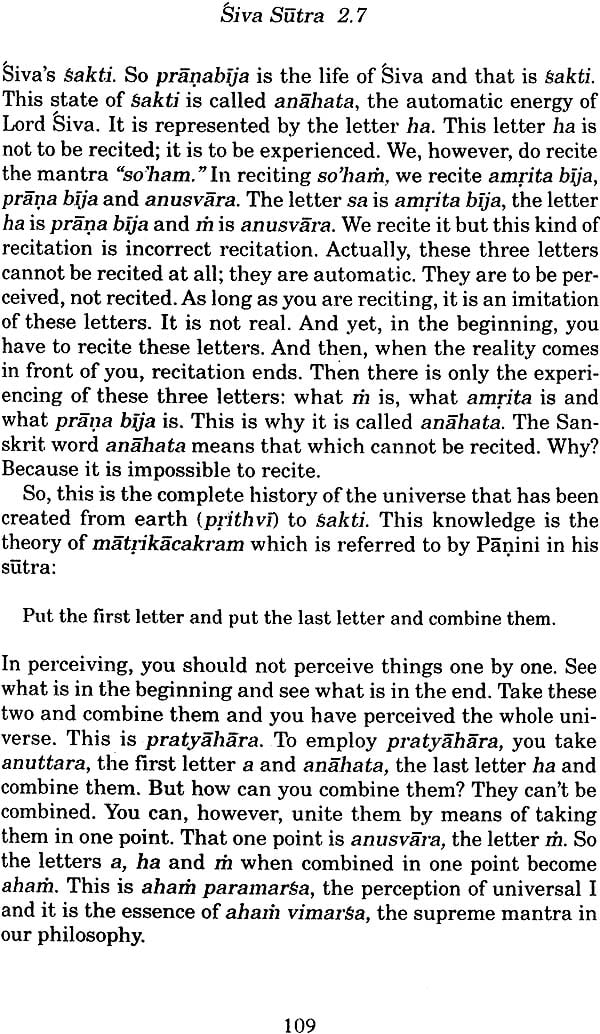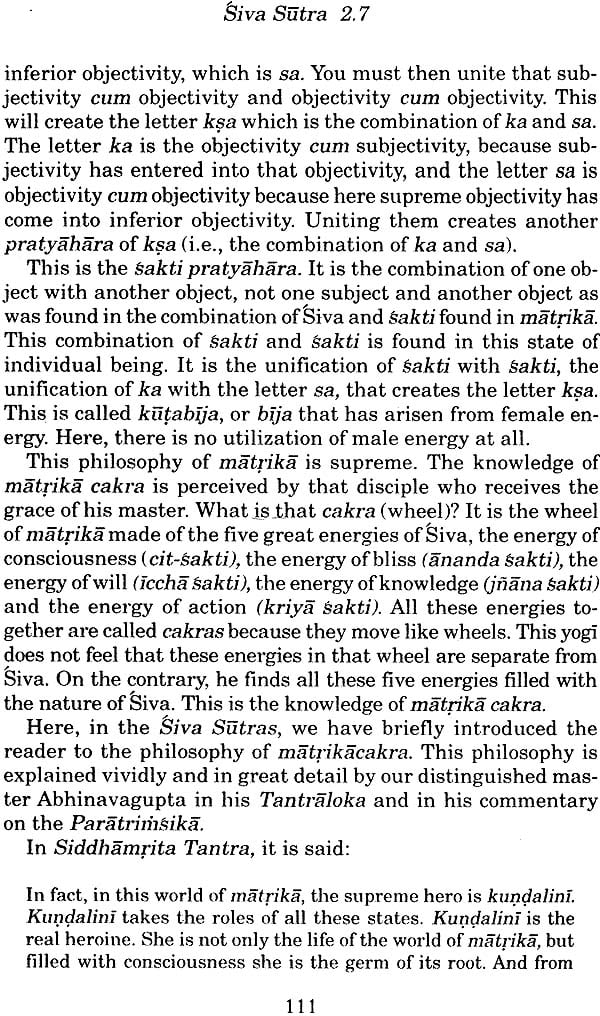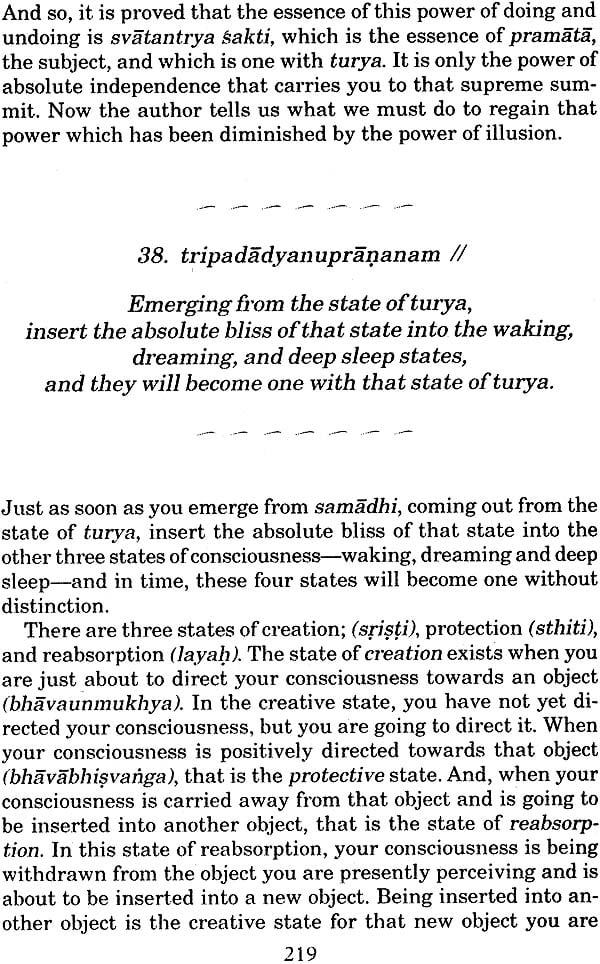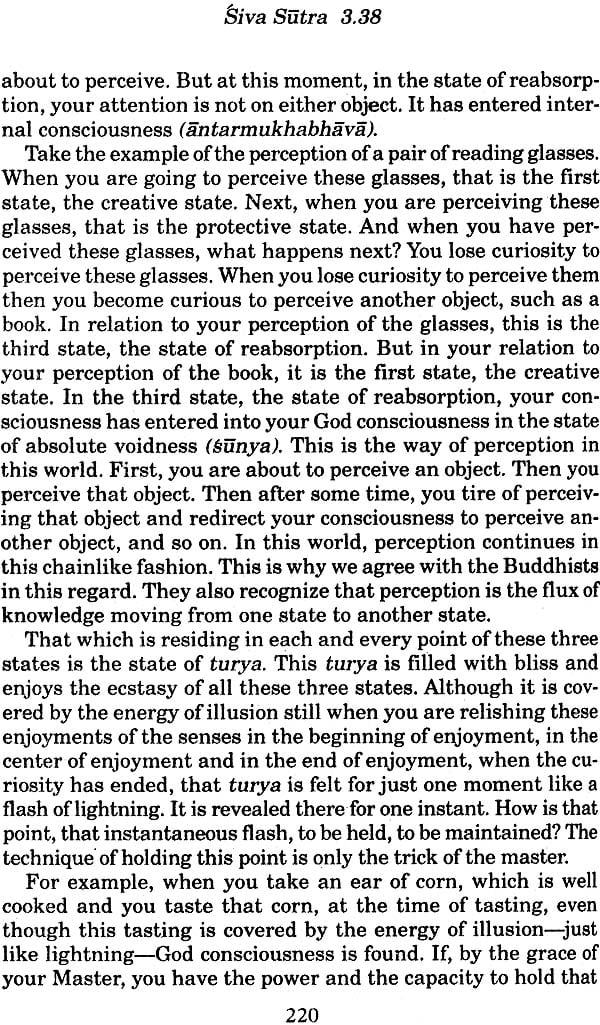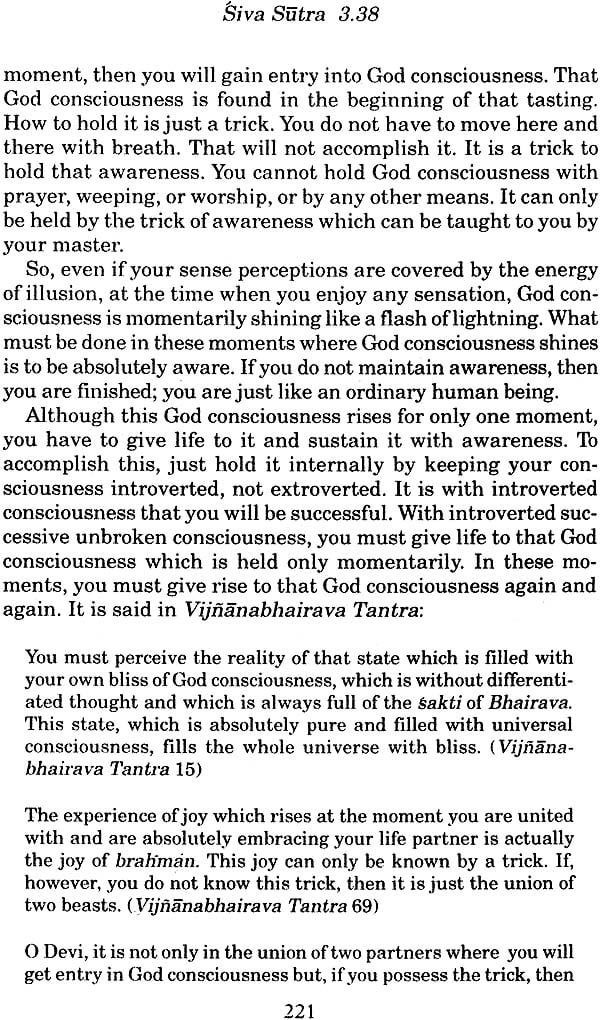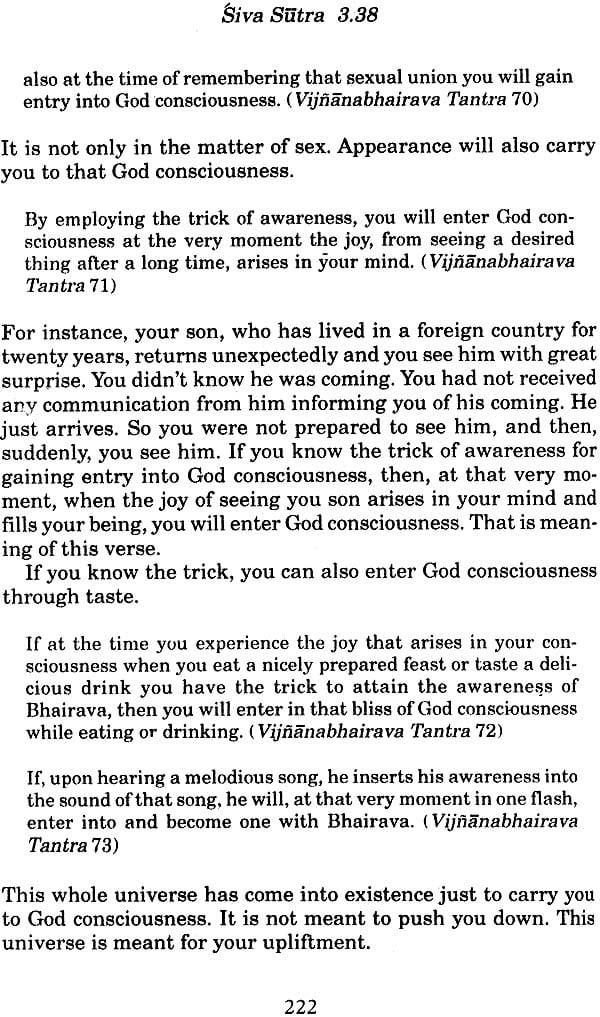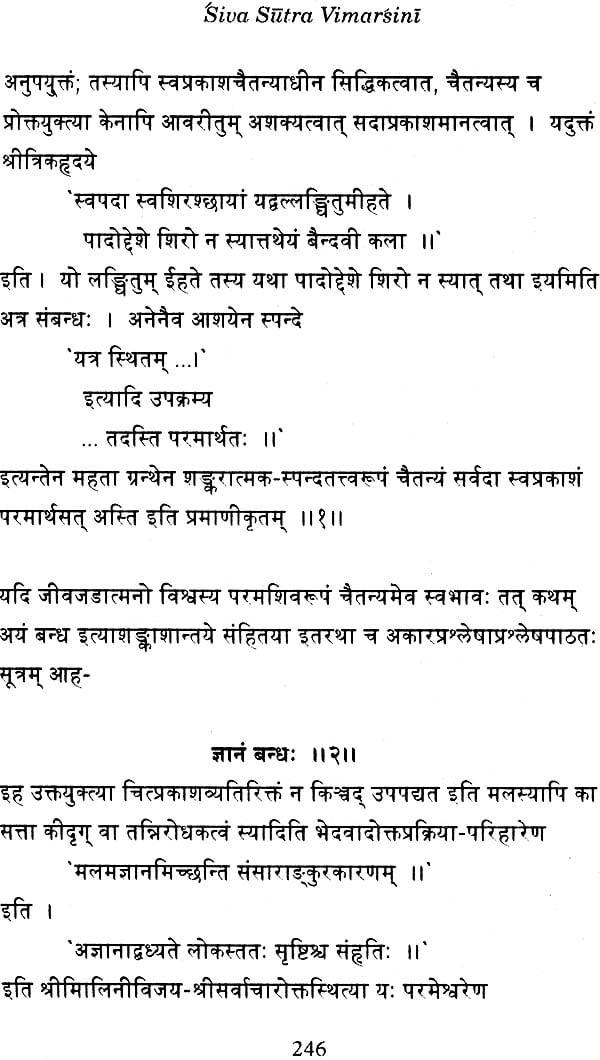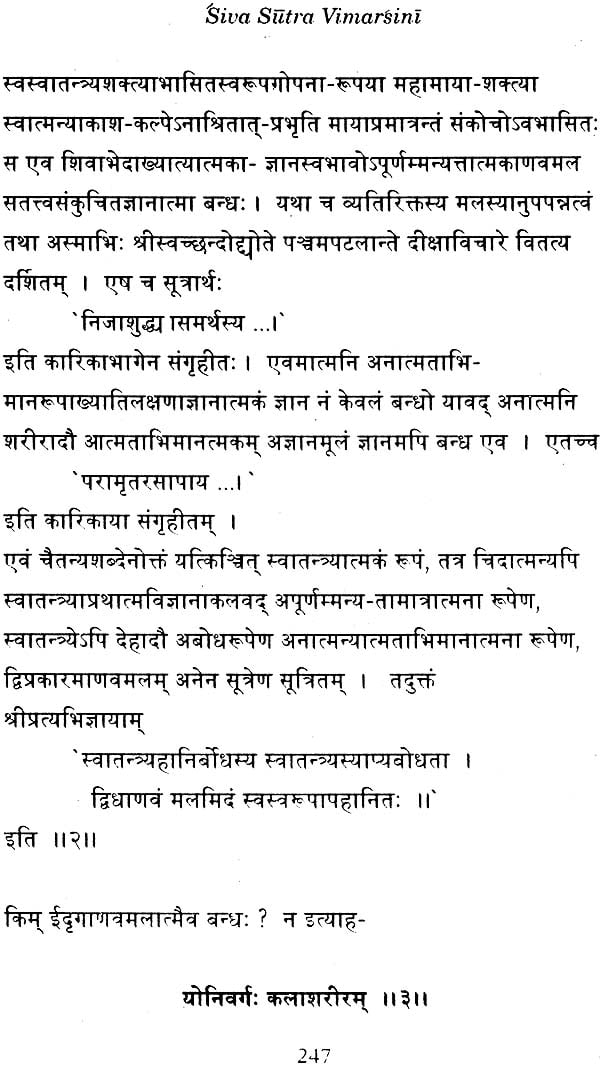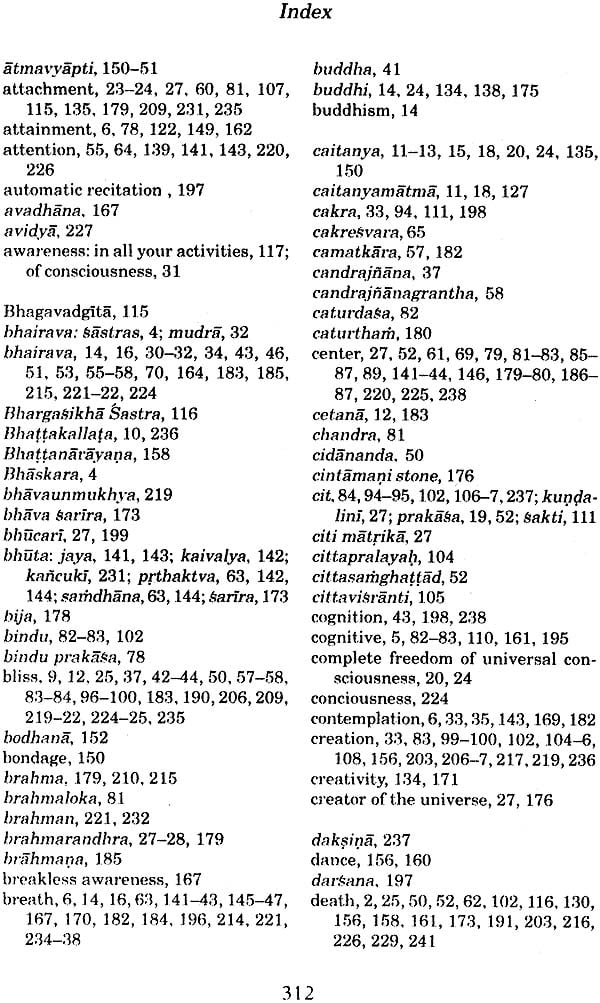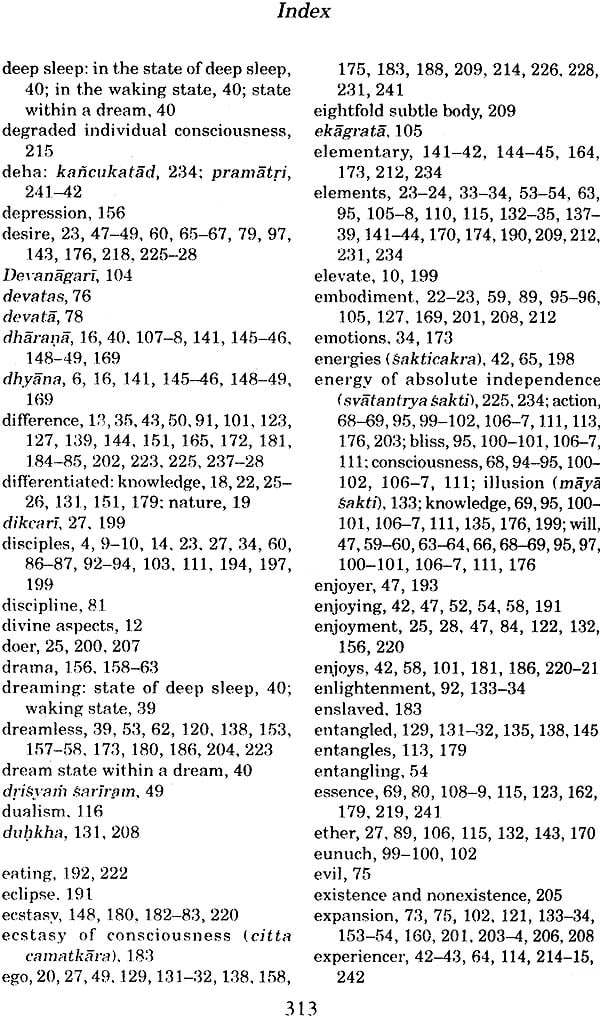
Siva (Shiva) Sutras: The Supreme Awakening (Revealed by Swami Lakshmanjoo)
Book Specification
| Item Code: | IDJ413 |
| Author: | Swami Lakshmanjoo, Edited John Hughes |
| Publisher: | MUNSHIRAM MANOHARLAL PUBLISHERS PVT LTD |
| Language: | English |
| Edition: | 2010 |
| ISBN: | 9788121511841 |
| Pages: | 348 (B/W Illus: 4) |
| Cover: | Paperback |
| Other Details | 8.3 X" 5.3" |
| Weight | 430 gm |
Book Description
About the Book
This book, Siva Sutras: The Supreme Awakening, isrevealed by the twentieth century's great philosopher saint Swami Lakshmanjoo. This spiritual treasure, gifted by God to the sage Vasugupta for the upliftment of humankind, is considered to be one of Kashmir Shaivism's most important scriptures. Here, Swami Lakshmanjoo gives the reader a penetrating vision of the glorious journey of the Supreme Awakening: the traveling from limited individuality to absolute oneness with God. This secret teaching, contained with these pages, is revealed by Swami Lakshmanjoo or the first time. Drawing on his own experience Swami Lakshmanjoo, basing his rendering on the esoteric commentary of Abhinavagupta's chief disciple Kshemaraja, shows us the way home.
Swami Lakshmanjoo was born in Srinagar, Kashmir on May 9, 1907. He was the last and the greatest of the saints and masters of the tradition of Kashmir Shaivism. Having a deep understanding of the philosophy and practices of Kashmir Shaivism, he was like a splendid and rare jewel. Beginning from childhood he spent his whole life studying and practicing the teachings of this unique sacred tradition. Because of his intellectual power and strength of awareness, he realized both spiritually and intellectually the reality of its thought.
Preface
This book is the distillation of over 16 tape, recorded audio lectures. It was Swami Lakshmanjoo's intent, in giving these lecture translations. To disclose in English the esoteric meaning of these Siva Sutras of Vasugupta as well as that of the commentary, called Vimarsini, by Ksemaraja, both of which were originally composed in Sanskrit. In attending these lectures it became obvious to this editor that Swami Lakshmanjoo was completely in command of his subject matter. Infact, his command of Sanskrit was superior to that of English, a condition he declared many times during his discourses. So, although absolutely fluent in Sanskrit many times he had to search or the appropriate word in English to clearly elucidate the Sanskrit texts. In fact on occasion he would tell us that he was not looking to translate the Sanskrit closely, but rather to give us the essential meaning of the text. Realizing that Kashmir Saivism is an oral tradition and to maintain the flavor and strict intent of Swami Lakshmanjoo's translation I have tried, as much as possible, to preserve his style of English and vocabulary. Because of this at times the English rendering may seem stilted, uneven and repetitive. I beg your indulgence and ask for your understanding in this regard. To be honest I am awed and humbled by the power and depth of Swami Lakshmanjoo's understanding. I only pray that I have been able to do justice to his rendering of this great Kashmir Shaiva scripture.
The text used by Swami Lakshmanjoo in this rendering is the Siva Sutra Vimarsini, published in 1911 as a volume in the Kashmir Series of Texts and Studies. This text was actually the first volume of an extensive series of Kashmir Shaiva texts which were collected, edited and published in the early part of the 20th century by the Research Department of Kashmir State under the authority of the Government of the Maharaja of Jammu and Kashmir. This work was done at the express wish of the Maharaja Pratab Singh who had a great fondness for Kashmir Saivism. Swami Lakshmanjoo, in using this early text of the Siva Sutra Vimarsini, discovered numerous errors, omissions and extraneous additions, which he corrected in his own copy and incorporated in this rendering. This original text in Devanagari, incorporating Swami Lakshmanjoo's textual corrections, is appended at the end of this book.
To preserve a smooth low of the text for the English reader, with the exception of the Sutras themselves the Sanskrit or the verses being referenced in Ksemaraja's commentary is not included in the body of this work. The interested Sanskrit reader can find these verses in their original Devanagari in the appendix
| Guide to Pronunciation | xx | |
| Preface | xxi | |
| Acknowledgements | xxiii | |
| The Author | xxv | |
| Introduction | 1 | |
| | ||
| 1.1 | caitanyamatma | 11 |
| Supreme consciousness is the reality of everything | ||
| 1.2 | jnanam bandhah | 18 |
| Knowing differentiatedly is bondage and not knowing undifferentiatedly is bondage. | ||
| 1.3 | yonivargah kalasariram | 22 |
| Mayiyamala and karmamala are also bondage. | ||
| 1.4 | jnanadhisthanam matrika | 26 |
| The Universal Mother commands this triple knowledge. | ||
| 1.5 | udyamo bhairavah | 30 |
| That effort, the flashing forth of active awareness that instantaneously makes universal consciousness shine, is Bhairava. | ||
| 1.6 | saktihcakrasamdhane visvasamharah | 32 |
| By establishing and meditating on the wheel of energies the differentiated universe comes to an end | ||
| 1.7 | jagratsvapnasusuptabhede turyabhogasambhavah | 36 |
| Such a heroic yogi experiences the expansive state of turya in the differentiated states of waking, dreaming and deep sleep | ||
| 1.8 | jnanam jagrat | 38 |
| External organic knowledge constitutes the waking state | ||
| 1.9 | svapno vikalpah | 38 |
| Internal perceptions and thoughts comprise the dreaming state | ||
| 1.10 | aviveko mayasausuptam | 39 |
| Forgetfulness and the negation of awareness is the dreamless state or maya | ||
| 1.11 | tritayabhokta viresah | 42 |
| The one who enjoys the oneness of the three states, waking, dreaming and deep sleep in turiya becomes the master of all organic energies. | ||
| 1.12 | vismayo yogabhumikah | 44 |
| The predominant sign of such a yogi is joy filled amazement | ||
| 1.13 | iccha saktiruma kumari | 46 |
| His will is the energy of Lord Siva and it is called uma and kumari, or | ||
| For such a yogi his will is one with the energy of Lord Siva, unobstructable, completely independent, always given to play | ||
| 1.14 | drisyam sariram | 49 |
| This entire perceived world is his own self, or His own body is just like an object to him. | ||
| 1.15 | hridaye cittasamghattad drisyasvapadarsanam | 52 |
| When his thoughts are diverted to the center of God consciousness then he eels the existence of God consciousness in oneness in the objective world and in the world of negation | ||
| 1.16 | Suddha-tattva-samdhanadva pasusaktih | 54 |
| Or by aiming at the pure element of Siva he possesses Siva's unlimited energy | ||
| 1.17 | vitarka atmajnanam | 56 |
| Any inference of such a yogi is knowledge of his own real self. | ||
| 1.18 | lokanandah samadhisukham | 57 |
| The joy of his mystical trance (samadhi) is bliss or the whole universe. | ||
| 1.19 | saktisandhane sarirotpattih | 59 |
| By infusing his energy of will the embodiment of that which is willed occurs at once | ||
| 1.20 | bhutasamdhana-bhutaprithaktva-visvasamghattah | 63 |
| By the greatness of this achievement of the energy of will the yogi can focus his awareness and heal the sick and suffering, separate elements from his body and be free from the limitations of space and time. | ||
| 1.21 | suddhavidyodyaccakresatva-siddhih | 66 |
| (When this yogi does not desire limited powers and is eager to attain the knowledge he becomes the master of the universal wheel) | ||
| 1.22 | mahahridanusamdhanan mantraviryanubhavah | 58 |
| By the attentive continuity of meditation on the great ocean of consciousness the power of supreme I is attained. | ||
| | ||
| 2.1 | cittam mantrah | 74 |
| Mind is mantra | ||
| 2.2 | prayatnah sadhakah | 78 |
| (For such a yogi) pauseless effort brings about his attainment of God consciousness. | ||
| 2.3 | vidyasarirasatta mantrarahasyam | 80 |
| The secret essence of mantra is establishment in the body of the knowledge of oneness | ||
| 2.4 | garbhe cittavikaso'visista vidyasvapnah | 87 |
| When a yogi's mind is satisfied with the expansive body of illusion then he falls in the world of differentiated perceptions and his knowledge of being is just like that of ordinary living beings | ||
| 2.5 | vidyasamutthane svabhavike Khecari sivavastha | 89 |
| The pure knowledge of God consciousness effortlessly rises and this state of Siva is realized as one with the state of Khecari. | ||
| 2.6 | gururupayah | 92 |
| The master (guru) is the means | ||
| 2.7 | matrikacakrasambodhah | 94 |
| (The disciple attains) the knowledge of the wheel of the hidden mother (Matrikacakra) | ||
| 2.8 | sariram havih | 114 |
| The establishment of I consciousness on the body be comes an offering in the ire of God consciousness. | ||
| 2.9 | jnanamannam | 116 |
| (For such a yogi) differentiated perception is his food, or Knowledge of his own nature is his food | ||
| 2.10 | vidyasamhare tadutthasvapnadarsanam | 119 |
| Although he is established in God consciousness in samadhi, yet not being able to maintain awareness, after a short time he enters into the dreaming state. | ||
| | ||
| 3.1 | atma cittam | 129 |
| Individual being is the mind entangled in the wheel o repeated birth and death. | ||
| 3.2 | jnanam bandhah | 131 |
| (or this limited individual), all knowledge is bondage | ||
| 3.3 | kaladinam tattvanamaviveko maya | 133 |
| Being unable to possess the undifferentiated knowledge of the 31 elements, you live in those elements, from kala to prithvi (earth), which are the expansion of the energy of illusion (maya sakti) | ||
| 3.4 | sarire samharah | 137 |
| You must make all the circles (kalas) in your body enter one into the other from gross to subtle. | ||
| 3.5 | nadisamhara-bhutajaya-bhutakaivalya-bhutaprithaktvani | 141 |
| The merging of the movements of breathing, controlling the gross elements, diverting attention from all objective senses and directing it towards the center of the movement of the breath. And removing your consciousness from the grip of the elementary field | ||
| 3.6 | mohavaranatsiddhih | 145 |
| These powers are brought into existence when a yogi's consciousness is covered by the energy of illusion (maya) | ||
| 3.7 | mohajayad anantabhogat sahajavidyajayah | 149 |
| After conquering the field of illusion (maya) by destroying its many impressions, one attains the victory of the pure knowledge of consciousness. | ||
| 3.8 | jagratdvitiyakarah | 153 |
| The waking stare is another formation of his real nature of consciousness | ||
| 3.9 | nartaka atma | 156 |
| The dancer in this field of universal dance is his self of universal consciousness. | ||
| 3.10 | rango'ntaratma | 159 |
| The player is the internal soul | ||
| 3.11 | preksakanindriyani | 161 |
| His own organs are spectators | ||
| 3.12 | dhivasatsattvasiddhih | 162 |
| By means of a supreme intellect filled with the awareness of the self, this yogi experiences that he is actually acting. | ||
| 3.13 | siddhah svatantrabhavah | 164 |
| The state of absolute independence is already achieved | ||
| 3.14 | yatha tatra tathanyatra | 165 |
| This (absolute independence) is the same in the external world as it was in samadhi | ||
| 3.15 | bijavadhanam | 167 |
| Maintain breakless awareness on that supreme energy which is the seed of the universe. | ||
| 3.16 | asanasthah sukham hrade nimajjati | 169 |
| Seated in that real posture, he effortlessly dives in the oceans of nectar | ||
| 3.17 | svamatranirmanamapadayati | 171 |
| Experiencing that this objective world is the product of his subjective consciousness, he can create anything he desires | ||
| 3.18 | vidya 'vinase janmavinasah | 173 |
| When his knowledge of the Self is permanently established, the, birth (and death) are gone forever. | ||
| 3.19 | kavargadisu mahesvaryadyah pasumatarah | 175 |
| In the world of letters, words and sentences, the eight energies of the Lord, who are the mothers of beasts (take control and hold him.) | ||
| 3.20 | trisu caturtham tailavadasecyam | 180 |
| The fourth state (turya) must be expanded like oil so that it pervades the other three: waking, dreaming and deepsleep. | ||
| 3.21 | magnah svacittena praviset | 182 |
| The yogi who is merged in his self must enter completely with his mind filled with great awareness | ||
| 3.22 | pranasamacare samadarsanam | 184 |
| When his breath begins to slowly move out toward the external state, then he also experiences the pervasion of God consciousness there | ||
| 3.23 | madhye 'varaprasavah | 186 |
| He does not experience the state of God consciousness in the center o these three states. | ||
| 3.24 | matrasvapratyayasamdhane nastasya punarutthanam | 188 |
| When a yogi, in coming out from samadhi, also attempts to maintain awareness of God consciousness in the objective world, then, even though his real nature of self is destroyed by the inferior generation self-consciousness, he again rises in that supreme nature of the self. | ||
| 3.25 | sivatulyo jayate | 190 |
| He becomes just like Siva | ||
| 3.26 | sariravrittirvratam | 191 |
| His virtuous behavior is the maintenance of his body | ||
| 3.27 | katha japah | 195 |
| Ordinary talk of life is the recitation of mantra | ||
| 3.28 | danamatmajnanam | 197 |
| His only purpose for remaining in his body is to impart his knowledge to others. | ||
| 3.29 | yo'vipastho jnahetusca | 198 |
| The one who rules the wheel of energies becomes the cause of inserting knowledge in others | ||
| 3.30 | svasaktipracayo'sya visvam | 201 |
| For him, this universe is the embodiment of his collective energies | ||
| 3.31 | sthitilayau | 203 |
| This universe is the expansion of his energy in objective impressions and in the dissolution of those impressions. | ||
| 3.32 | tatpravritavapyanirasah samvettribhavat | 206 |
| Although he is determined in creating, protecting and destroying the universe, even then he is not separated the real state of his subjectivity | ||
| 3.33 | sukhaduhkhayorbahirmananam | 208 |
| He experiences his joy and his sadness just like an object, with "This-consciousness" separate from his being | ||
| 3.34 | tadvimuktastu kevali | 210 |
| Separated from pleasure and pain, he is established in real seclusion | ||
| 3.35 | mohapratisamhatastu karmatma | 212 |
| The yogi whose God consciousness is destroyed by this state of illusion is dependent on his action | ||
| 3.36 | bhedatiraskare sargantarakarmatvam | 214 |
| He drives away the field of differentiated perceptions and enters into a new world of God consciousness. | ||
| 3.37 | karana saktih svato'nubhavat | 217 |
| The power of creation is the experience of every individual. | ||
| 3.38 | tripadadyanuprananam | 219 |
| Emerging from the state of turya, insert the absolute bliss of that state into the waking, dreaming and deep sleep states and they will become one with that state | ||
| 3.39 | citta sthitivaccharira karanabahyesu | 224 |
| The awareness of God consciousness should not only be infused in that state where one's mind is established in one-pointedness but it should also be infused in the establishment of his body, in his organic action and in the external objective world. | ||
| 3.40 | abhilasadhahirgatih sambahyasya | 226 |
| Due to the insatiable and insistent desire to fill that gap (in his nature), his flow and movement are toward the objective world, not subjective consciousness, and so he is carried from one birth to another. | ||
| 3.41 | tadarudhapramitestatksayajjiva samksayah | 228 |
| All desire vanishes in that fortunate person whose consciousness is established in his own real nature. Or him the state of being a limited individual has ended. | ||
| 3.42 | bhutakancuki tada vimukto patisamah parah | 231 |
| For him, the five elements are only coverings. At that very moment, he is absolutely liberated, supreme and just like Siva | ||
| 3.43 | naisargikah pranasambandhah | 234 |
| This connection with breathing in and breathing out is his nature. | ||
| 3.44 | nasikantarmadhyasamyamat, kimatra, savyapasavyasausumnesu | 237 |
| If his consciousness is established in the central vein in that force, which is the energy of life (pranan), then he remains always the same. For him there is no difference in traveling in prana, Apana or susumna. | ||
| 3.45 | bhuyah syatpratimilanam | 239 |
| This yogi simultaneously and repeatedly experiences the revealing state and the concealing state of the objective world. | ||
| Conclusion | 241 | |
| Siva Sutra Vimarsini Sanskrit Text | 243 | |
| Index | 311 |
